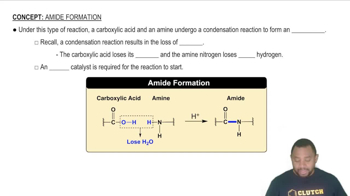The following observations are made about a diprotic acid H2A: (i) A 0.10 M solution of H2A has pH = 3.30. (ii) A 0.10 M solution of the salt NaHA is acidic. Which of the following could be the value of pKa2 for H2A: (i) 3.22, (ii) 5.30, (iii) 7.47, or (iv) 9.82?
Atmospheric CO2 levels have risen by nearly 20% over the past 40 years from 320 ppm to 400 ppm. (a) Given that the average pH of clean, unpolluted rain today is 5.4, determine the pH of unpolluted rain 40 years ago. Assume that carbonic acid 1H2CO32 formed by the reaction of CO2 and water is the only factor influencing pH. CO21g2 + H2O1l2 Δ H2CO31aq2

Verified Solution
Key Concepts
pH Scale

Carbonic Acid Formation

Acid-Base Equilibrium

The amino acid glycine 1H2N¬CH2¬COOH2 can participate in the following equilibria in water: H2N¬CH2¬COOH + H2OΔ H2N¬CH2¬COO- + H3O+ Ka = 4.3 * 10-3 H2N¬CH2¬COOH + H2OΔ+H3N¬CH2¬COOH + OH- Kb = 6.0 * 10-5 (a) Use the values of Ka and Kb to estimate the equilibrium constant for the intramolecular proton transfer to form a zwitterion: H2N¬CH2¬COOH Δ +H3N¬CH2¬COO-
The amino acid glycine 1H2N¬CH2¬COOH2 can participate in the following equilibria in water: H2N¬CH2¬COOH + H2OΔ H2N¬CH2¬COO- + H3O+ Ka = 4.3 * 10-3 H2N¬CH2¬COOH + H2OΔ+H3N¬CH2¬COOH + OH- Kb = 6.0 * 10-5 (b) What is the pH of a 0.050 M aqueous solution of glycine?
At 50 °C, the ion-product constant for H2O has the value Kw = 5.48 * 10-14. (a) What is the pH of pure water at 50 °C? (b) Based on the change in Kw with temperature, predict whether ΔH is positive, negative, or zero for the autoionization reaction of water: 2 H2O1l2 Δ H3O+1aq2 + OH-1aq2
Butyric acid is responsible for the foul smell of rancid butter. The pKa of butyric acid is 4.84. (b) Calculate the pH of a 0.050 M solution of butyric acid.
